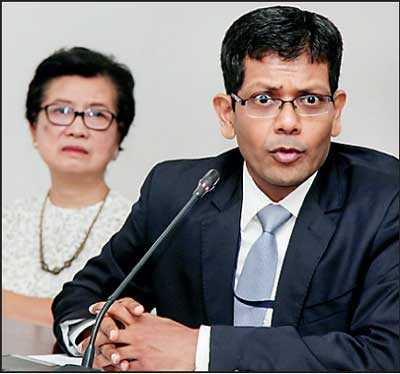Monday Jan 05, 2026
Monday Jan 05, 2026
Friday, 5 April 2019 00:00 - - {{hitsCtrl.values.hits}}
The Asian Development Bank (ADB) yesterday said Sri Lanka’s economic growth is projected to pick up to 3.6% in 2019 and further to 3.8% in 2020 from 3.2% in 2018.
 |
ADB Sri Lanka Resident Mission Senior Country Economist Utsav Kumar with ADB Country Director of the Sri Lanka Resident Mission Sri Widowati - PIc by Chamila Karunarathne |
ADB’s flagship annual economic publication Asian Development Outlook (ADO) 2019, forecasts a gradual recovery supported by a turnaround in the construction sector and continued growth in services. The agriculture sector, which picked up pace in 2018 after two years of weak performance, is expected to continue growing at the same pace assuming weather conditions remain normal.
“While the economy is projected to recover over the next two years, for Sri Lanka to sustain and accelerate growth, fiscal and structural reforms remain essential,” said ADB Sri Lanka Resident Mission Senior Country Economist Utsav Kumar.
“Addressing policy constraints will be critical to avoiding repeated macroeconomic pressures and to generating sustained sources of foreign exchange earnings.”
ADB said proposals announced in the Budget 2019 will support private expenditure and thus growth. The public investment to gross domestic product (GDP) ratio is expected to pick up and will be an impetus to investment and the construction sector.
Overall, the Budget aims to keep the primary balance in surplus in 2019 and 2020 and reduce the fiscal deficit further, thereby maintaining the path of fiscal consolidation.
Headline inflation, as measured by the national consumer price index, is expected to inch up to 3.5% in 2019 and further to 4.0% in 2020 stemming from a pickup in economic activity, base effect for inflation, and a strengthening in non-food and core inflation observed since late 2018 and early 2019.
The current account deficit will drop to 2.5% of GDP in 2019 and increase marginally in 2020. A recovery in agriculture exports, continued increase in tourist earnings, and a slowdown in vehicle imports will contribute to a decline in current account deficit.
Though the impact of Brexit on the overall Sri Lankan economy is estimated to be marginal, a downside risk to the garment sector emanates from a no-deal Brexit scenario involving a possible tariff escalation between Sri Lanka and the UK. The large repayments on account of external debt servicing and political uncertainties may affect market sentiment and exert pressure on the Sri Lankan rupee.
A key policy challenge for the Sri Lankan economy is recurrent weather-related disasters in 2016 and 2017 that have had multiple impacts as evidenced by slow economic growth, high domestic food prices, a high oil import bill, high government spending, and high number of food-insecure households limiting daily minimum calorie intake.
With a large proportion of the population close to the poverty line, gains made in poverty reduction over the past two decades may be at risk from exposure to disasters. Sri Lanka needs to focus on areas prone to disasters and to move toward a more disaster-resilient economy by preventing and mitigating consequences of weather-related hazards. Efforts also need to be made toward mobilising funds for risk reduction and adaptation, establishing the right policy framework, and building institutional capacity.
ADB is committed to achieving a prosperous, inclusive, resilient, and sustainable Asia and the Pacific, while sustaining its efforts to eradicate extreme poverty. In 2018, it made commitments of new loans and grants amounting to $ 21.6 billion. Established in 1966, it is owned by 68 members – 49 from the region.
